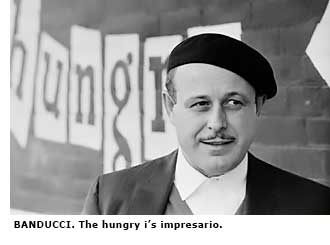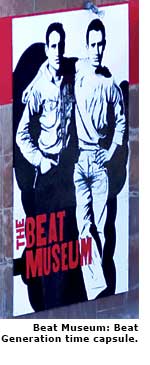Bohemia by the Bay: Looking Back on the Beat Generation - Page 6
11. HUNGRY I
The brick-wall décor duplicated in stand-up comedy clubs across the nation is said to have originated at the hungry i, the venue opened by colorful North Beach impresario Enrico Banducci at 599 Jackson Street, after he'd purchased the enterprise with a hip and mysterious name in the mid-'50s from its previous owner, Eric 'Big Daddy' Nord.

Interspersed with the comedy of such critical minds as Mort Sahl, Woody Allen, and Lenny Bruce was live music from national touring jazz and folk acts. The Kingston Trio recorded at the club, as did the Limeliters, musical satirist Tom Lehrer, and Mort Sahl. As its national reputation grew, the hungry i also helped boost the careers of comedians Bill Cosby, Godfrey Cambridge, and Professor Irwin Corey, as well as neighborhood resident Vince Guaraldi.
It is said that Banducci bowed to the pleadings of a very young Barbra Streisand, granting her an extended booking in the late '50s that served as her steppingstone to national fame.
By dint of the cutting-edge comedy in particular, and despite its relatively sophisticated setting, the hungry i attracted Beat audiences as well as such local cognoscenti as the young Ned Eichler and his parents.
By the mid-'60s, with stand-up and folk less in fashion, Banducci had decided to sell the club and concentrate his efforts on the café that still bears his given name, at 504 Broadway.
12. THE CELLAR
The reputation of this little venue at 576 Green Street preceded its opening in the heart of North Beach in 1956, with crowds five times the 100-person capacity soon clamoring to get in.
Sometimes called The Jazz Cellar, it had been converted by jazz musicians Wil Carlson, Jack Minger, and Sonny Nelson from an old Chinese restaurant into one of the city's best-loved showcases for bebop and progressive music, alongside the nearby Jazz Workshop, the Black Hawk in the Tenderloin district, and a few venues further west in the Fillmore and Richmond districts.
A week after opening the nightclub, Nelson invited a friend, the 26-year-old poet ruth weiss, to read her work with jazz accompaniment. It was a hit—and a draw for Beat audiences seeking late-night entertainment, as well as for such aspiring bebop musicians as the young Larry Vuckovich. "Then I started asking other poets to come and join me," weiss recalls, "none of who ever gave me any credit, and some who became very famous."
Veteran poet Kenneth Rexroth picked Lawrence Ferlinghetti, still relatively unknown for his verse, to partner with him in a live recording at the Cellar on the Fantasy label, accompanied by the 'Cellar Jazz Quintet.' Jack Kerouac professed his love for The Cellar in his writing, extolling "the girls with dark glasses and blonde hair, the brunettes in pretty coats by the side of their little boy (The Man)—raising beer to their lips, sucking in cigarette smoke, beating to the beat of the beat of Bruce Moore, the perfect tenor saxophone..."
A MUSEUM WHERE
THE BEATS LIVE ON

The Beat Generation continues to carry on its rich legacy in the heart of San Francisco's North Beach—thanks to Jerry Cimono, the nouveau-Beat entrepreneur behind the neighborhood's fascinating Beat Museum.
In 2006, a half-century after it began to thrive, Beat culture became enshrined at 540 Broadway Street, around the corner from the landmark City Lights Books. The Beat Museum's grand opening featured readings and recollections by Beat icons Michael McClure and Al Hinkle as well as John Allen Cassady, son of the late Neal and the surviving Carolyn Cassady.
Under the direction of Cimino, the venue has since continued to regularly host celebrations of poetry and prose by visionary writers dead and living.
In keeping with dioramas found at other kinds of museums, there's an evocation, particularly on the upper level, of a lived-in 1950s Beat pad, with furniture, fixtures, and a typewriter of that era. Bop and West Coast 'Cool Jazz' burbles in the background.
Individual exhibits showcase such landmark works as Kerouac's 'On the Road' and Ginsberg's 'Howl,' and enlarged photos of Beat luminaries adorn the walls. Supplementing City Lights' holdings, a vast collection of books of Beat literature, poetry, and culture (as well as of the Hippie and rock cultures that followed) are for sale. There are also audio and video recordings, posters, postcards, and the like.
Cimino and his staff are fabulously knowledgeable and friendly. Check them out at kerouac.com and 1-800-KER-OUAC.
Photos: Elliott Erwitt, Burt Glinn, and Dennis Stock (all courtesy Magnum Photos); Jerry Stoll (courtesy Casey Stoll), C.R. Snyder; and courtesy ruth weiss, Larry Vuckovich, San Francisco History Center (S.F. Public Library), Corbis Sales
Ginsberg painting: Danny O'Connor
Special thanks to Brad Rosenstein of SFPALM
• For more on the Beat Generation, including some precious archival video footage, don't miss 'The Source,' Chuck Workman's compelling and intelligent DVD documentary on the subject.




